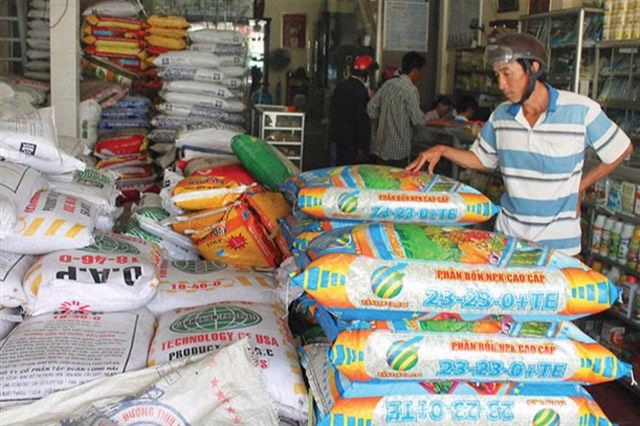
HÀ NỘI — The Ministry of Agriculture and Rural Development (MARD) has proposed a value-added tax on fertiliser products to support domestic producers.
According to existing regulations, fertilisers are not imposed value-added tax (VAT). Therefore, fertiliser production enterprises do not have declaration, deduction and refund of VAT for input materials. That has made input costs high, causing selling prices to increase.
With the high selling price, domestically-made fertiliser producers cannot compete with imported products, and farmers must face higher production costs.
The ministry has also proposed to review the export tax policy for urea, Diammonium Phosphate and Monoammonium Phosphate fertilisers and have export control measures for those fertilisers to meet the domestic demand.
According to the Ministry of Industry and Trade (MoIT), fertiliser exports saw high growth in the first four months, up 46.9 per cent in volume and 192.6 per cent in value due to increased export prices.
MoIT said it would review the domestic demand for this strategic product to take appropriate management measures for export and import activities.
That would take advantage of the high prices to enhance exports and ensure supply for domestic consumption, especially if raw material prices rose too high.
Regarding the domestic market, due to the influence of the upward price trend on the world market, fertiliser prices have increased compared to the previous month.
Besides that, the risk of supply chain disruption due to trade tensions and the Russia-Ukraine conflict, and high freight rates have also affected the domestic fertiliser industry.
The domestic fertiliser price is continuously increasing, causing difficulties in agricultural production.
From the end of 2020 until now, fertiliser prices have continuously increased, especially since the beginning of 2022.
Fertiliser prices have been recorded at VNĐ16-18 million per tonne depending on the kinds of fertiliser, the highest level for 50 years.
The fertiliser cost accounts for more than 40 per cent of input cost, so the high fertiliser price will directly affect the price of agricultural products. However, farmers cannot increase the price of agricultural products.
According to Nguyễn Trí Ngọc, vice chairman of the Việt Nam Fertiliser Association, the increase in fertiliser prices has been due to the strong rise in oil prices.
This is the major input material for producing inorganic fertilisers such as nitrogen and urea fertiliser products.
Many other materials and chemicals for fertiliser production, logistics costs and labour costs have also increased. Especially, as Việt Nam mainly imports potassium from Russia and Ukraine, where there is a conflict leading to supply disruptions and higher prices.
Nguyễn Phú Cường, chairman of the Việt Nam Chemical Group (Vinachem), said that to produce DAP fertiliser, producers must buy sulfur from Russia and the Middle East or potassium from Russia and Belarus due to little supply from the domestic market. Difficulties from these markets had pushed raw material prices up.
The sulfur price increased from $340-350 per tonne to $420-430 in just two months. The cost of potassium surged from$200-300 per tonne to $1,000 now.
Ngọc said now that the global oil price was still above US$100 per barrel, and there was no sign of falling below this price. Therefore, the fertiliser prices would not be able to decrease. If the price drops, it would have only a slight decrease, forming a new price level.
According to Phùng Hà, an expert in the chemical fertiliser production industry, the fertiliser costs are forecast to increase continuously, so Việt Nam needs to have policies on controlling the fertiliser price increase to support farmers.
According to MARD, Việt Nam needed 10.7 million tonnes of fertiliser in 2021, including 7.2 million tonnes from the domestic supply.
The nation exported 1.6 million tonnes. The fertiliser demand for agricultural production in 2022 was estimated not to have large changes compared to 2021.
To ensure enough fertiliser supply for the upcoming Summer-Autumn crop, domestic fertiliser manufacturers plan to enhance production, providing a stable supply.
Cường said Vinachem’s plants were maintaining stable operation to ensure enough fertiliser supply on the domestic market with a total capacity of 1 million tonnes per year at Hà Bắc and Ninh Bình fertiliser plants and 600,000 tonnes of DAP fertiliser at the two plants DAP1 and DAP2 if they have enough ore for production.
Besides that, Hà said MARD needed to strengthen consulting activities and technical guidance on fertiliser use to help farmers use efficiently agricultural materials, including fertiliser.
It is necessary to encourage domestic plants to increase the production of organic fertilisers to reduce dependence on urea, DAP and MAP fertilisers. The output of organic fertiliser has also reached about 3 million tonnes, basically meeting the domestic demand.
Nguyễn Như Cương, director of the Department of Crop Production, said that in the future, farmers should promote the use of organic fertilisers. Besides, the ministry should encourage farmers to produce organic fertilisers from available by-products and apply technology to reduce the amount of used fertiliser.
This would help reduce fertiliser costs in agricultural production and, at the same time, move towards green production. —- VnExpress News
- Reduce Hair Loss with PURA D’OR Gold Label Shampoo
- Castor Oil Has Made a “Huge” Difference With Hair and Brow Growth
- Excessive hair loss in men: Signs of illness that cannot be subjective
- Dịch Vụ SEO Website ở Los Angeles, CA: đưa trang web doanh nghiệp bạn lên top Google
- Nails Salon Sierra Madre
 VnExpress News The News Gateway of Vietnam
VnExpress News The News Gateway of Vietnam




